Short-Term Consumption of Freeze-Thawed Microwaved Food Impaired Blood Electrolytes and Lipids In Female Rats
| Received 31 Jul, 2022 |
Accepted 01 Apr, 2023 |
Published 21 Apr, 2023 |
Background and Objective: Dual application of freezing and microwave heating is the most common form of food processing for food with a pleasant taste and texture in commercial and domestic settings. The effect of these processing methods on food was usually investigated in male laboratory animals, while such effects on female rats are sparse data. This study was poised to investigate the effects of various processing methods of foods on the cardiovascular risk and oxidative parameters in female Wistar rats. Materials and Methods: Four groups of female rats were employed in the study. Groups 1 to 4 were fed standard rat-chow (CG), freeze-thawed rat-chow (FT), microwaved rat-chow (MO) and freeze-microwaved rat-chow (FM), respectively, for 6 weeks. Results: The study showed that the plasma HDL-C was not altered (p>0.05) compared with the control group, however, the plasma cholesterol, triglycerides, LDL-C and VLDL-C of the rats fed the experimental rat chows were significantly elevated (p<0.05) than the CG group. In addition, the experimental foods altered the natremia and oxidative parameters, however, no significant (p>0.05) lipid oxidation was recorded. Conclusion: This study demonstrated that short-term consumption of freeze-microwaved food might not have a pronounced effect on oxidative parameters. However, freeze-microwaved food is safer than consumption of either freeze-thawed or microwaved foods, however, there is a need to investigate the long-term effect of this claim.
| Copyright © 2023 Atunnise et al. This is an open-access article distributed under the Creative Commons Attribution License, which permits unrestricted use, distribution, and reproduction in any medium, provided the original work is properly cited. |
INTRODUCTION
Microwave is one of the most explored frequency-based electromagnetic energy-generating technologies, which has become indispensable in every human endeavour1 with telecommunication and medical industries’ applications. The advent and incorporation of microwave technology into agricultural, food and beverages industries are evolutionarily dynamic1,2. Its application in heating foods and food products preservation and sometimes food processing such as baking, drying, pasteurisation, thawing, tempering and sterilisation are enormous and highly rewarding due to its convenience, efficiency and prudence.
Amid overwhelming popularity and acceptability, scepticism persists with microwaved oven usage and its adverse health effect being a severe concern3,4. There are claims that extreme direct exposure to microwave radiation is lethal4. However, most such reports are associated with job hazards, primarily via telecommunications devices. The recent advancements seem to be aggressively mediating its effect to be more eco-friendly5. Also, microwaved foods are rarely consumed without an initial application or introduction of such materials to other food preservation or processing methods, especially freezing and conventional heating and heat radiation6-9.
The increased trend in metabolic disorders, cardiovascular and other atherogenic conditions and stress-induced ageing is gaining unprecedented attention from public health organisations and their affiliates7,8. Several factors, like oxidative stress indices, remain the major causes either from a sedentary lifestyle, hereditary and epigenetic mechanisms and consumption of foods that enhance free-radicals generation, thus, microwaved oven-heated foods are not exempted8,9.
To date, microwaved food consumption is sparingly evaluated as a co-application processing method, especially in female subjects. There is a shortage of information on the comparative effect of microwaved foods with freeze-thawed food-one of the most combined foods preserving and heating methods. This study aimed to evaluate the relative and co-application of freeze-thawing and microwave heating effects on the lipids and oxidative indices in female albino rats fed food exposed to these preserving and heating processes.
MATERIALS AND METHODS
Study area and duration: This study was conducted at the Biochemistry Laboratory, Centre for Chemical and Biochemical Research, Redeemer’s University, Ede, Osun State, Nigeria, in August, 2021 and spanned till February, 2022.
Research protocol: Twenty female albino Wistar rats were obtained from the Physiology Department, University of Ibadan, Nigeria and housed in the Redeemer’s University Facility to sacclimatise for 10 days. They were fed standard rat chow and accessed clean tap water during acclimatisation.
The standard rat chow was subjected to either freeze-thawing, microwave-heating or both but skipped the thawing phase. The freezing temperature was -20°C for 24 hrs and it thawed at room temperature. The thawing lasted until the feed temperature returned to average room temperature. The microwave heating was applied on the feed for 2.5 min/100 g, while freeze-microwave was done by freezing for 24 hrs and then microwaved for (auto-reheat) 2.5 min. These feed-processing methods gave rise to three feed categories and a control group as follows:
| • | Control (CG): Normal rat-chow | |
| • | Freeze-thawing (FT): Normal rat-chow+-20°C freezing (12 hrs)+thawing | |
| • | Microwave-heating (MO): Microwaved (2.5 min)/100 g rat chow | |
| • | Freeze+microwave (FM): -20°C freezing (12 hrs)+microwaved (auto-reheat) 2.5 min |
The rats had access to their feeds and water ad libitum and 12 hrs of light and darkness and the feed administration lasted for 6 weeks.
Rats were fasted overnight and sacrificed by the cervical dislocation method10, after which blood was collected via cardiac puncture into citrate and heparin bottles for different analyses. The blood collected was centrifuged at 4000 rpm for 5 min and plasma was collected for biochemical studies. All animal care and handling complied with the Redeemer’s University Research and Animal Management Committee guidelines and the Guide for the Care and Use of Laboratory Animals, 8th edition11.
Plasma cholesterol, High-Density Lipoprotein Cholesterol (HDL-C) and plasma triglycerides (TAG) were determined using the enzymatic method using Randox® Kits and the procedure followed was according to the manufacturer's manual. Low-Density Lipoprotein Cholesterol (LDL-C) and Very-Low-density Lipoprotein (VLDL-C) were obtained by deduction using the Friedewald equation. The atherogenic index (AI) was also calculated12. The catalase (CAT) and superoxide dismutase (SOD) activities were assayed according to the Sinha13 and Misra and Fridovich14,15 protocols, respectively. The procedure was followed by Beutler and Kelly16 to estimate the plasma reduced-glutathione (GSH) concentration.
Statistical analysis: All data were computed in SPSS version 23.0 and analysed using a One-way Analysis of Variance (ANOVA). The Duncan’s Multiple Range Test assessed the significance level at p<0.05.
RESULTS
Figure 1 showed the plasma lipid profiles of rats fed processed rat-chows in single and co-application methods of freeze-thawing and microwave. The total plasma cholesterol level in rats fed different processed feed (experimental groups) was significantly higher (p<0.05) than in the control group, a similar trend was recorded in the plasma LDL-C of the rats. Although the plasma HDL-C of the experimental and control groups was not significantly altered (p>0.05), however, the plasma triglycerides and VLDL in the group fed freeze-thawed rat-chow were significantly higher (p<0.05) than in the control group.
The plasma electrolytes (sodium, potassium and calcium) was shown in Fig. 2. The plasma calcium of the experimental groups (FT, MO and FM) was not significantly different (p>0.05) from the control group. Also, the plasma potassium of the FT, MO and MF was not significantly different (p>0.05) from the control group, however, the plasma potassium content of the FT was significantly lower (p<0.0.05) than the MO and MF. The plasma sodium in FT, MO and MF was significantly elevated (p<0.05) compared to the control group. Additionally, the plasma sodium of the MO was significantly higher (p<0.05) than in the FT and MF rats.

|
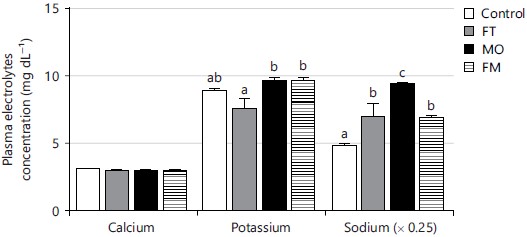
|

|
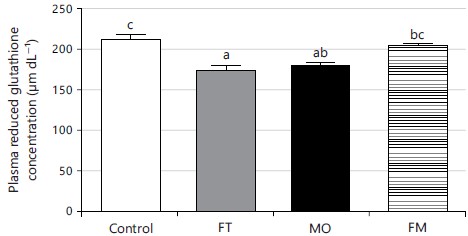
|
The atherogenic index of the control and rats fed experimental rat-chow was depicted in Fig. 3. The AI of the MO and FT was not significantly different (p>0.05) from the control group, however, the FT was significantly higher (p<0.05) than the control rats.
The plasma reduced-glutathione of rats fed freeze-thawed, microwaved, freeze-microwaved rat chows and standard rat-chow was shown in Fig. 4. Compared to the normal rat-chow group, a significant decrease (p<0.05) in GSH was observed in the freeze-thawed and microwaved treated rat-chow-fed groups. No significant difference (p>0.05) was noted between the freeze-microwave and normal rat-chow-fed rat groups. Additionally, no significant (p>0.05) change was recorded between the microwaved and freeze-microwaved groups.
Figure 5 represented that the plasma superoxide dismutase activity of the FT, MO, FM and CG rat groups. The plasma SOD activity of FT, MO and FM was significantly lower (p<0.05) than in the control group. Also, the plasma SOD activity of FT and FM was significantly higher (p<0.05) than in the MO group.
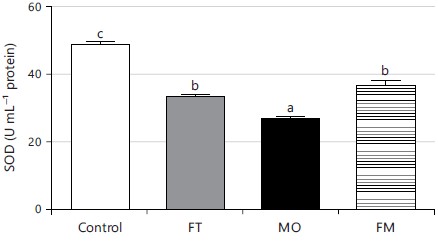
|
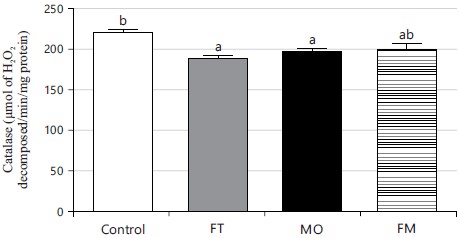
|
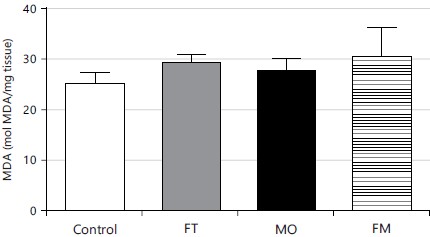
|
The plasma catalase (CAT) activity in CG, FT, MO and FM groups was shown in Fig. 6. A significant decrease (p<0.05) in CAT activity was recorded in the FT and MO compared to the control group. However, the FM was not significantly different (p>0.05) from the CG group. Also, no significant change (p>0.05) was recorded between the FT, MO and FM groups.
The lipids peroxidation (malondialdehyde) level in the plasma of the rats fed microwaved and freeze-thawed rat-chows was shown in Fig. 7. There was no significant (p>0.05) change in the plasma MDA level of the experimental groups (FT, MO and FM) when compared with the control group.
DISCUSSION
The differential effect of various applications on lipid profile, oxidative stress and electrolyte imbalance in female rats were observed in this study. After 6 weeks of feeding groups of rats with microwaved, FT, freeze-microwaved and standard rat-chow, the plasma cholesterol and LDL-C of the experimental groups were significantly elevated (p<0.05) than the control group. This significant increase suggests that freezing, microwaving and combining the two methods may induce hypercholesterolemia, consequently forming plaque on the blood vessel as a deposit17-20. The increased plasma cholesterol and LDL-C may be ascribed to the ability of microwave heating to increase the free lipids contents, which may enhance the unregulated adsorption of fats in the gastric tract, especially the short-chain fatty acids and aromatic lipids18-23. Additionally, microwave heating oxidation or transformation of some aromatic lipids molecules could also impair the hepatic biotransformation of such lipids and result in unregulated concentration in the blood. Previous reports have shown that a few minutes of pulse microwave application on food material caused the transformation of lipids and hydrolysis of triglycerides23-25, while Khalil et al.24 showed that microwave enhances lipids extraction in flaxseed. Freezing alike has been reported to induce a high alteration of the fat content of fish products26. Thus, this may explain why this study’s freeze-thawing method induced hypercholesterolemia in female rats.
Although hypercholesterolemia and elevated LDL-C were recorded in the rats fed the experimental rat-chow, the plasma HDL-C of the rats was not altered significantly (p>0.05) by any processing methods. Though this seemingly positive effect may appear innocuous, the increase in LDL may protect the LDL-C/HDL-C ratio, because HDL-C has been considered a pivotal chylomicron subunit that can be used in proportion with LDL-C to predict the risk of systemic impaired lipids transportation and deposition27.
In this study, the plasma calcium and potassium levels in the experimental rat groups were not altered significantly (p>0.05) compared with the control group. The role of blood electrolytes in switching between an individual’s physiological and pathological states has maintained the frontline in recent studies and the dietary influence on these electrolytes is remarkable28,29. Also, the plasma sodium was significantly (p<0.05) elevated in the experimental groups and the MO was doubly elevated compared with the control group. This increase may be ascribed to the fact that microwave heating has been reported to increase the mineral bioavailability of some food and edible products like fish meals30. Dietary regulation of blood electrolytes such as sodium, calcium and potassium is an effective non-pharmacological approach to managing cardiovascular disease31. Furthermore, freezing has been reported to reduce minerals of plant products such as vegetables32 significantly, this was not the case because hypernatremia was also recorded in the group fed FT rat-chow. Interestingly, the FM had a significantly (p<0.05) lower natremia than the MO group.
This investigation revealed that neither microwaved rat-chow nor freeze-microwaved rat-chow significantly (p>0.05) poses a threat to the atherogenic index of plasma. However, FT rat chow significantly (p<0.05) increased the risk of the atherogenic index of plasma in rats. Plasma atherogenic index is a strong marker to predict the risk of atherosclerosis and coronary heart disease and is associated with the size of pre-and anti-atherogenic lipids constituents33. Literature has shown that the number of freeze-thawing cycles is proportional to lipid peroxidation intensity of food materials33-35 and consequent elevated atherogenic risk in female rats.
The GSH, SOD and CAT play some important enzymatic and non-enzymatic roles in preventing free radicals-mediated cellular stress and injuries. At the same time, lipids peroxidation is an index of the overwhelming effect of reactive oxygen species35,36.
In this study, the SOD activity and GSH were altered (p<0.05) significantly, however, the CAT and LPO level were not significantly (p<0.05). Thus, no significant oxidative stress was recorded.
This study demonstrated that the domestic use of microwave ovens for food preservation and quality enhancement might not pose any significant atherogenic risk and oxidative stress in the short term, however, using a microwave oven to defrost frozen food items is relatively safer than room-temperature thawed food. Hence, it is recommended that concurrent application of refrigeration and microwaving-a process that is often applicable in fast-food outlets, should be encouraged to moderate atherogenic risk induced by the consumption of freeze-thawed or microwaved foods.
CONCLUSION
This study revealed that short-term consumption of freeze-thawed food might increase cardiovascular risk, while microwave-heated food induced hypernatremia. However, the sequential application of freezing and microwaved heating (freezing-microwaving) seems not to cause any significant dyslipidemia and oxidative stress in the plasma of female rats.
SIGNIFICANCE STATEMENT
This study revealed that short-term consumption of microwaved food poses no significant health risk via oxidative stress induction, plasma electrolyte distortion and lipidemic status in females. Nonetheless, microwaved heated frozen food was further shown to be safer than consuming each processing method singly. Thus, reports from this work will be beneficial in further substantiating the safety of microwaved food for female health. This study will help the researchers uncover the critical areas of nutritional safety of the combined application of frozen and microwave-heating in females that many researchers have yet to explore. Thus. A new approach to freeze-thawed food safety is improved when microwaved heat thaws frozen food.
ACKNOWLEDGMENTS
We acknowledge Redeemer’s University for providing a laboratory facility. We appreciate the effort of Daramola G.G. and Abraham A's effort for their laboratory assistance during this project.
REFERENCES
- Chandrasekaran, S., S. Ramanathan and T. Basak, 2013. Microwave food processing-A review. Food Res. Int., 52: 243-261.
- Bows, J.R., 1999. Variable frequency microwave heating of food. J. Microwave Power Electromagn. Energy, 34: 227-238.
- Waseem, M., S. Akhtar, N. Ahmad, T. Ismail, C.E. Lazarte, M. Hussain and M.F. Manzoor, 2022. Effect of microwave heat processing on nutritional indices, antinutrients, and sensory attributes of potato powder-supplemented flatbread. J. Food Qual., 2022: 2103884.
- Tran, T., L. Yang, H. Zhou, D. Pan and D. Xu, et al., 2022. Evaluating quality indexes of frozen vegetables prepared with different cooking oils during 12 months of frozen storage. Food Meas., 16: 1404-1415.
- Kumar, A., Y. Kuang, Z. Liang and X. Sun, 2020. Microwave chemistry, recent advancements, and eco-friendly microwave-assisted synthesis of nanoarchitectures and their applications: A review. Mater. Today Nano, 11: 100076.
- Stein, Y. and I.G. Udasin, 2020. Electromagnetic hypersensitivity (EHS, microwave syndrome)-Review of mechanisms. Environ. Res., 186: 109445.
- Egea, J., I. Fabregat, Y.M. Frapart, P. Ghezzi and A. Görlach et al., 2017. European contribution to the study of ROS: A summary of the findings and prospects for the future from the COST action BM1203 (EU-ROS). Redox Biol., 13: 94-162.
- Nguyena, T.P. and S. Songsermponga, 2022. Microwave processing technology for food safety and quality: A review. Agric. Nat. Resour., 56: 57-72.
- Ejaz Ul Haq, M., M.S.H. Akash, S. Sabir, M.H. Mahmood and K. Rehman, 2020. Human exposure to bisphenol A through dietary sources and development of diabetes mellitus: A cross-sectional study in Pakistani population. Environ. Sci. Pollut. Res., 27: 26262-26275.
- Aguwa, U.S., C.E. Eze, B.N. Obinwa, S.N. Okeke and S.F. Onwuelingo et al., 2020. Comparing the effect of methods of rat euthanasia on the brain of Wistar rats: Cervical dislocation, chloroform inhalation, diethyl ether inhalation and formalin inhalation. J. Adv. Med. Med. Res., 32: 8-16.
- NRC, 2010. Guide for the Care and Use of Laboratory Animals. 8th Edn., National Academies Press, Washington, DC, USA, ISBN-13: 9780309186636, Pages: 211.
- Holmes, D.T., J. Frohlich and K.A. Buhr, 2008. The concept of precision extended to the atherogenic index of plasma. Clin. Biochem., 41: 631-635.
- Sinha, A.K., 1972. Colorimetric assay of catalase. Anal. Biochem., 47: 389-394.
- Misra, H.P. and I. Fridovich, 1972. The role of superoxide anion in the autoxidation of epinephrine and a simple assay for superoxide dismutase. J. Biol. Chem., 247: 3170-3175.
- Misra, H.P. and I. Fridovich, 1976. The oxidation of phenylhydrazine: Superoxide and mechanisms. Biochemistry, 15: 681-687.
- Beutler, E. and B.M. Kelly, 1963. The effect of sodium nitrite on red cell GSH. Cell. Mol. Life Sci., 19: 96-97.
- Zheng, Y., C. Li, J. Yang, S. Seery and Y. Qi et al., 2022. Atherogenic index of plasma for non-diabetic, coronary artery disease patients after percutaneous coronary intervention: A prospective study of the long-term outcomes in China. Cardiovasc. Diabetology, 21: 29.
- Mirinezhad, M.R., H. Ghazizadeh, M. Aghsizadeh, M.Z. Bidary and A. Naghipour et al., 2022. The relationship between genetic variants associated with primary ovarian insufficiency and lipid profile in women recruited from MASHAD cohort study. BMC Women's Health, 22: 2.
- Rooiqoh, Q.F., D.G. Tamtomo and R. Cilmiaty, 2022. Blood sugar levels and lipid profiles of T2DM among hypertension patients in Bambanglipuro Health Centre. Epidemiol. Soc. Health Rev., 4: 29-35.
- Domínguez, R., M. Pateiro, M. Gagaoua, F.J. Barba, W. Zhang and J.M. Lorenzo, 2019. A comprehensive review on lipid oxidation in meat and meat products. Antioxidants, 8: 429.
- Verma, V., A. Verma, A.K. Mishra, H.T.A. Khan, D.C. Nath and R. Narang, 2022. Bayesian Estimation of Gender Differences in Lipid Profile, Among Patients With Coronary Artery Disease. In: Handbook of Intelligent Computing and Optimization for Sustainable Development, Manshahia, M.S., V. Kharchenko, E. Munapo, J.J. Thomas and P. Vasant (Eds.), Scrivener Publishing LLC Wiley, Cummings Center, USA, ISBN: 9781119792642, pp: 753-769.
- Siddique, R., A.F. Zahoor, H. Ahmad, F.M. Zahid and E. Karrar, 2021. Impact of different cooking methods on polycyclic aromatic hydrocarbons in rabbit meat. Food Sci. Nutr., 9: 3219-3227.
- Kim, D., J. Choi, G.J. Kim, S.K. Seol and S. Jung, 2011. Accelerated esterification of free fatty acid using pulsed microwaves. Bioresour. Technol., 102: 7229-7231.
- Khalil, A.A., A. Aslam, A. Khalid, Quratul Ain Shahid and M. Aslam et al., 2020. Hypocholesterolemic effect of microwave assisted defatted flaxseed extract in experimental rats. J. Microbiol. Biotechnol. Food Sci., 10: 493-499.
- Telahigue, K., T. Hajji, I. Rabeh and M. El Cafsi, 2013. The changes of fatty acid composition in sun dried, oven dried and frozen hake (Merluccius merluccius) and sardinella (Sardinella aurita). Afr. J. Biochem. Res., 7: 158-164.
- Zhang, R., Y. Fan, Y. Xue, Y. Feng and C. Dong et al., 2022. The LDL/HDL ratio predicts long-term risk of coronary revascularization in ST-segment elevation myocardial infarction patients undergoing percutaneous coronary intervention: A cohort study. Braz. J. Med. Biol. Res., 55.
- Ali, S.A.A.M., M.O.A. Gibreel, N.S.E.K.B. Suliman, A.K.A. Mohammed and B.Y.M. Nour, 2022. Significance of serum electrolyte pattern in an Eastern Sudanese dengue fever patients population. Open J. Med. Microbiol., 12: 1-10.
- Amon, A.S., R.Y. Soro, E.F. Assemand, E.A. Due and L.P. Kouame, 2014. Effect of boiling time on chemical composition and physico-functional properties of flours from taro (Colocasia esculenta cv fouê) corm grown in Cote d'Ivoire. J. Food Sci. Technol., 51: 855-864.
- Stephen, N.M., R.J. Shakila, G. Jeyasekaran and D. Sukumar, 2010. Effect of different types of heat processing on chemical changes in tuna. J. Food Sci. Technol., 47: 174-181.
- Mill, J.G., M.P. Baldo, M. del Carmen B. Molina, M.I. Schmidt and S.M. Barreto et al., 2019. Sex-specific patterns in the association between salt intake and blood pressure: The ELSA-Brasil study. J. Clin. Hypertens., 21: 502-509.
- Rahman, M.H., M.M. Hossain, S.M.E. Rahman, M.R. Amin and D.H. Oh, 2015. Evaluation of physicochemical deterioration and lipid oxidation of beef muscle affected by freeze-thaw cycles. Korean J. Food Sci. Anim. Res., 35: 772-782.
- Zhang, X., X. Zhang, X. Li, J. Feng and X. Chen, 2019. Association of metabolic syndrome with atherogenic index of plasma in an urban Chinese population: A 15-year prospective study. Nutr. Metab. Cardiovasc. Dis., 29: 1214-1219.
- Ali, S., N. Rajput, C. Li, W. Zhang and G. Zhou, 2016. Effect of freeze-thaw cycles on lipid oxidation and myowater in broiler chickens. Braz. J. Poult. Sci., 18: 35-40.
- Wang, Z., Z. He, D. Zhang, X. Chen and H. Li, 2021. Effect of multiple freeze‐thaw cycles on protein and lipid oxidation in rabbit meat. Int. J. Food Sci. Technol., 56: 3004-3015.
- Aslam, S. and A.M. Yousafzai, 2017. Chromium toxicity in fish: A review article. J. Entomol. Zool. Stud., 5: 1483-1488.
- Zandi, P. and E. Schnug, 2022. Reactive oxygen species, antioxidant responses and implications from a microbial modulation perspective. Biology, 11: 155.
How to Cite this paper?
APA-7 Style
Atunnise,
A.K., Salau,
T.B., Avwioroko,
O.J., Adeniji,
P., Lawal,
A., Salau,
B.A. (2023). Short-Term Consumption of Freeze-Thawed Microwaved Food Impaired Blood Electrolytes and Lipids In Female Rats. International Journal of Biological Chemistry, 17(1), 1-9. https://doi.org/10.3923/ijbc.2023.01.09
ACS Style
Atunnise,
A.K.; Salau,
T.B.; Avwioroko,
O.J.; Adeniji,
P.; Lawal,
A.; Salau,
B.A. Short-Term Consumption of Freeze-Thawed Microwaved Food Impaired Blood Electrolytes and Lipids In Female Rats. Int. J. Biol. Chem 2023, 17, 1-9. https://doi.org/10.3923/ijbc.2023.01.09
AMA Style
Atunnise
AK, Salau
TB, Avwioroko
OJ, Adeniji
P, Lawal
A, Salau
BA. Short-Term Consumption of Freeze-Thawed Microwaved Food Impaired Blood Electrolytes and Lipids In Female Rats. International Journal of Biological Chemistry. 2023; 17(1): 1-9. https://doi.org/10.3923/ijbc.2023.01.09
Chicago/Turabian Style
Atunnise, Adeleke, Kazeem, TiOluwani Bamidele Salau, Oghenetega Jonathan Avwioroko, Paulina Adeniji, Abiola Lawal, and Bamidele Adewale Salau.
2023. "Short-Term Consumption of Freeze-Thawed Microwaved Food Impaired Blood Electrolytes and Lipids In Female Rats" International Journal of Biological Chemistry 17, no. 1: 1-9. https://doi.org/10.3923/ijbc.2023.01.09

This work is licensed under a Creative Commons Attribution 4.0 International License.



